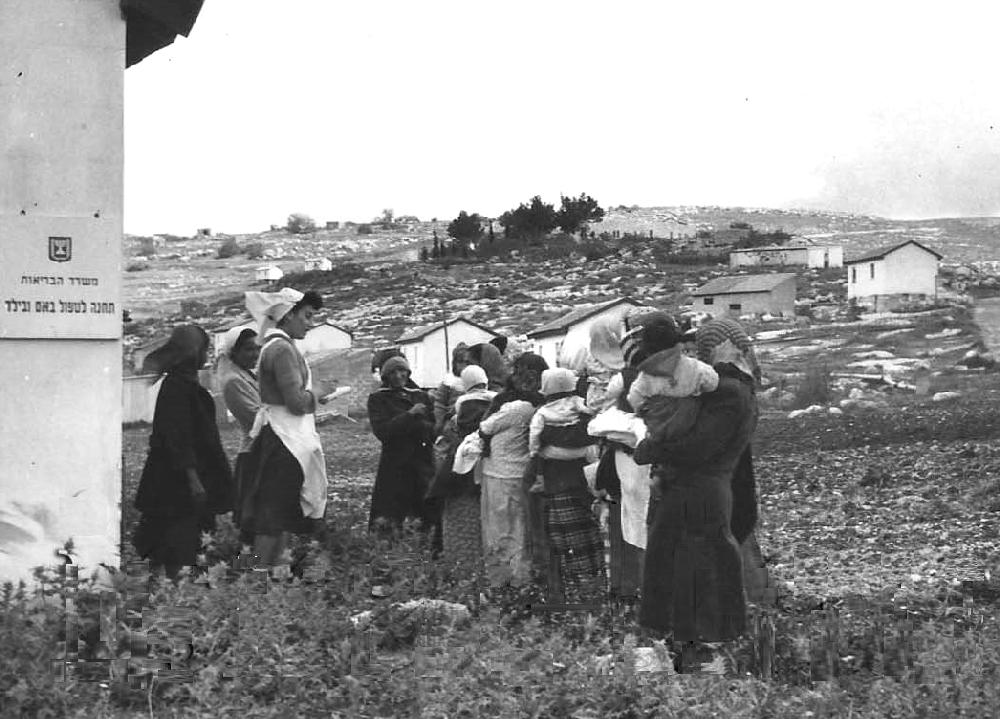
Israeli Institutions: Public Health

Figure 1.--The new state of Israel in iherited a substantial public health system thanks to the Jewish community and the British Mandate. Here we see a Station for Health Mother & Child in the countryside during the 1950s. We are not sure, but they look to be serving a Palestinian Arab community.
|
|
Diseases was rampant in the Ottoman Empire (19th century). Mot modern medicine was developed in the Christian West. Health standards and medical care was virtually medieval, especially outside the major cities. The situatiion was worse in the Arab Lands, at the time part of the Ottoman Empire. The Arab lands in general were backward and neglected provinces of the Ottoman Empire. This was the situation that Jewish Zionist settlers encountered when they began arriving in Palestine (late 19th century). Some of the most common diseases were dysentery, malaria, typhus and trachoma. One of the early steps taken by the settlers was to organize health services. This began in the Old City of Jerusalem. European Jewish communities began setting up clinics. This included free medical services for low income patients. The health workers became well known for their dedicated care working in primitive conditions with very little money before hospitals were founded. These early clinics in Jerusalem grew to become very impressive hospitals: Bikur Holim (1843), Misgav Ladach (1888), and Shaare Zedek (1902). They still operare to day, now equipped with modern equipment and medical technology. The Hadassah Medical Center in Jerusalem with important schools of medicine, nursing, and pharmacology and two modern hospitals. The Center began with the work of two nurses who were sent to Jerusalem by the Hadassah Women's Zionist Organization of America (1913). The foundation of Israel's modern health system was laid by the Jewish community and by the British during the Mandate Era (1918-48). This included a network of medical services for prevention, diagnosis, and treatment. This included an effort to extend services into the ciountryside with kibbutzes and Arab villages. As a result, when Israel was founded there existed medical infrastructure more advanced than in other Arab countries. Immunization was already standard procedure. There was also a frameworks for improving environmental conditions. A new problenm emerged with independence, especially the health needs of hundreds of thousands of refugees not only from post-War Europe, but an even larger number of refugees from Arab countries where Jews were being targetted and expelled. A major national effort was lunched by the new state wih only limited resources. Medical services as well as a far-reaching plan of health education and preventive medicine. Israel is today served by one of the most advanced health care system n the world. It includes an extensive medical network including hospitals, outpatient clinics, and centers for preventive medicine and rehabilitation. Hospital care includes advanced procedures and techniques. There are also mother-and-child care centers, for women during pregnancy and children from birth to early childhood, offer prenatal examinations, early detection of mental and physical handicaps, immunizations, regular pediatric check-ups, and health education.
HBC

Navigate the Boys' Historical Clothing Web Site:
[Return to the Main Israeli institution page]
[Return to the Main Isreali page]
[Return to the Main public health page]
[Activities]
[Biographies]
[Chronology]
[Clothing styles]
[Countries]
[Bibliographies]
[Contributions]
[FAQs]
[Glossaries]
[Images]
[Links]
[Registration]
[Tools]
[Boys' Clothing Home]
Created: 9:43 PM 11/10/2018
Last updated: 9:43 PM 11/10/2018



